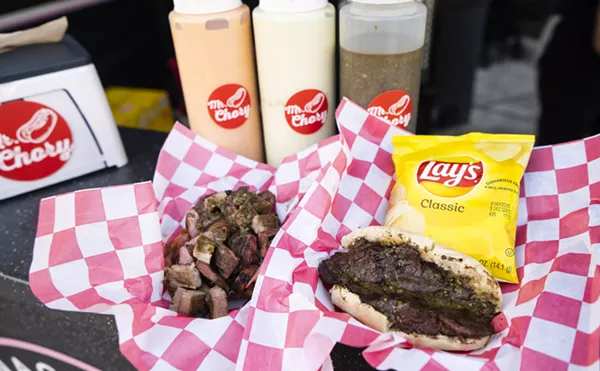The two resorts have another thing in common — they're aiming to grab Mobil five-star designations in two risky locations. Fort Lauderdale has never exactly been a playground for jetsetters, despite the best efforts of our marketing mavens, and Singer Island is just depressing. What must have once been one of the most beautiful tropical oceanside landscapes in the world, the island named for the sewing machine dynasty has been colonized by ugly, 20-story high-rises, ossified towers rising like bones upended in a desert; all you need are a few Blade Runner-style choppers whizzing between rooftops to complete the picture of futuristic anomie. That's your beachfront, thank you very much. Across the street, you've got your '70s concrete-block bungalows whose middle-class owners have been none too happy, over the years, to watch their ocean access steadily whittled down to a point and finally vanish. Nowadays, the old residents must drive down to MacArthur Park Beach like the rest of us, a patch of pristine wilderness at the northern end of the island that must have been extra nice when John D. Mac used to skinny-dip there with his Air Force flyboys.
Any intimations of ruinous sprawl that might have haunted your journey into this dystopic Transfuture vanish, at any rate, when you step from your car into the waiting arms of the hunky uniformed valets and skip through the massive front doors of the Resort's lobby. Looking around at the swooping, curved, floor-to-ceiling screens; the luscious, pillow-strewn chairs in jewel tones of gold, white, and blue — from the time you first set foot on these richly tapestried marbled floors the color and texture of wet sand, you are happy.
Happy. Is this the price of contentment — $210 mil? The Resort is no great shakes to look at from the outside, just one more bony tower, but the interiors, designed by Santa Monica firm Hirsch Bedner, are sigh-inducingly lovely (Hirsch Bedner likes to claim that its hotel interiors function as backdrops for guests who become "actors in a fantasy environment"). At just over a month old, after all, few Gucci- and Fendi-clad fannies have creased the lounge seats, few spike-heeled pumps have punched itty-bitty holes in the striated wood plank floors that lead to the dining room, and the staff — still shiny, still solicitous — is too new to be jaded; they're as excited about working under such gorgeous uplighting as you are to be basking in it. The restaurant is sited on the ocean, of course, with floor-to-ceiling windows, white leather banquettes, free-spirited abstract oils, and a walk-in wine storage room. An open kitchen (more curves) dominates the front — staffed by efficient, ponytailed line cooks. White linen-covered tables set with square gold chargers and watery, asymmetric bowls are tucked by the windows and back behind semitransparent drapes. The waiters wear beautiful ties.
Carlos Jorge is executive chef here. After you're settled in, Jorge and his minions send out a sprightly little amuse bouche, a dab of sweet-salty crab meat and jeweled cubes of pink grapefruit and chopped mint balanced on a pristine green leaf of baby chard. Just a single precious mouthful. Then around comes the guy with the bread tray — warm rolls, plain, raisin, or multigrain — to slather with soft, sweet butter.
Jorge was previously at the Raleigh in South Beach, and he's paid his dues, working his way up the food chain via stints at big-time New York restaurants like Mercer Kitchen (one of Jean-Georges Vongerichten's productions) and as sous chef at Butter in the Village. He worked directly with Eric Ripert of Le Bernadin while he was at the Raleigh. It's a fancy pedigree, and Jorge doesn't fool around — every plate he sends out exudes a professional polish and subtle flair but without a lot of silliness. There is no foam here. And certainly no truffle oil. The menu leans heavily to fresh, cleanly prepared seafood with references to Asia and the Caribbean, playful takes on Eastern standards like a hot, sour, and sweet kobe beef salad ($18) and pad Thai with prawns, ginger, tamarind, and cilantro ($32) or Vietnamese summer rolls with shrimp ($17). Snapper is bathed in coconut curry; grouper is scented with adobo seasoning and served with mashed plantains and sweet potatoes; a shellfish hotpot makes a brew of mussels, shrimp, and clams seasoned with chorizo, garlic, and cilantro. A couple of "almost raw" offerings include a trio of ceviches made with conch, yellowtail, and sea scallops ($19) and a tuna tartare ($16). Selections from the "Earth" offer Island jerk lamb ($36) and duck breast with glazed beets and tempura Okinawan sweet potatoes ($34).
Jorge's menu is small and precisely focused. You get the sense of harmonies deftly woven — there is no appetizer, for instance, that wouldn't make a terrific starter for any of the entrées. The flavor profiles of each dish are distinct, yet the whole menu is of a piece. It's a quiet, modest vision that's immensely pleasing when you realize how rare it is for chefs these days to exert such self-control.
We started with the Kobe beef salad and fried ravioli stuffed with lump crab and celeriac ($18). The Kobe salad is a 210-million-dollar-take on Thai beef salad — emerald-green stalks of watercress tossed with daikon radish and cucumber, larded with paper-thin slivers of melting Kobe beef, a hot-and-sour dressing given texture and weight with ground peanuts. This was wonderful. Oversized ravioli were golden and gently crusted, stuffed with a flavorful mix of lump crab and faintly celery-scented celeriac, a drizzle of shrimp and lemongrass nage to swipe each mouthful through. This too came with a perfectly dressed watercress salad, fresh and cool and peppery.
We followed these with seared branzino fillet ($32); the fish of the night — mahi — which comes with your choice of three sauces (market price was $29.95); and a lobster salad ($22). The branzino — a Venetian striped bass — was superb, fillets bathed in a broth made with white miso and flavored with ginger, with the lightest of vegetables — wilted bok choy and cubes of kabocha squash, the Japanese version of pumpkin or butternut. The branzino's skin had been seared crisp for texture, and it exuded a condensed, sea-rich flavor against the tender white flesh. Since we couldn't decide which sauce to have with the mahi, we asked for two, the first a gorgeous raspberry-colored vinaigrette made from the sweet, lavender-fleshed Okinawan potatoes from Hawaii, the second a mustardy, pale-yellow Dijon wakame. The potato vinaigrette was fruity and faintly sweet; the Dijon-wakame, flavored with brown seaweed, was sharper on the palate — but both were excellent, unexpected accompaniments to this very fresh fish. Along with a deconstructed lobster salad (baby arugula on one side, on the other, a terrine of lobster chunks, mined with hearts of palm and mango tahini dressing and set on a pink round of watermelon), these three dishes made one of the prettiest palettes of tropical colors I've ever seen on one table.
Desserts at Solu are a knockout — particularly the chef's choice "dessert flight" ($28), enough for three of us and as varied and delightful an ending as you could ask for. A baked chocolate egg roll, warm and soft in the center, came topped with luscious mango-banana salsa; lychee fruit coated in milk chocolate had been set on a sugared mille feuille alongside a chunk of sake-soaked mango; there were miniature cinnamon-sugared churros; a fantastic crème brûlée decorated with candied ginger; and a deep-purple sweet potato pie festooned with a taro chip and served alongside chewy, housemade minimarshmallows.
Prices are high. Solu may be a special-occasion restaurant for most of us — but what an occasion! Our nice waiter was content to let us linger as long as we wanted, tucked into our leather booth by a window, and truly we didn't want to go anywhere at all — if we'd planned ahead, we might have just commandeered one of those $400-a-night suites (discounted for the grand opening) and stayed the night, with a massage the next morning and a dip under the waterfall. No doubt the view from the 21st floor is spectacularly unobstructed. When you've got a choice, it's always preferable to be on the inside looking out. 3800 N. Ocean Dr., Singer Island. Open for breakfast Monday through Friday 6:30 till 11 a.m., Saturday and Sunday 7:30 till 11:30 a.m. Lunch Monday through Friday 11:30 a.m. till 2:30 p.m., Saturday and Sunday noon till 2:30 p.m. Dinner nightly 5:30 till 10:30 p.m. Call 561-340-1795.










